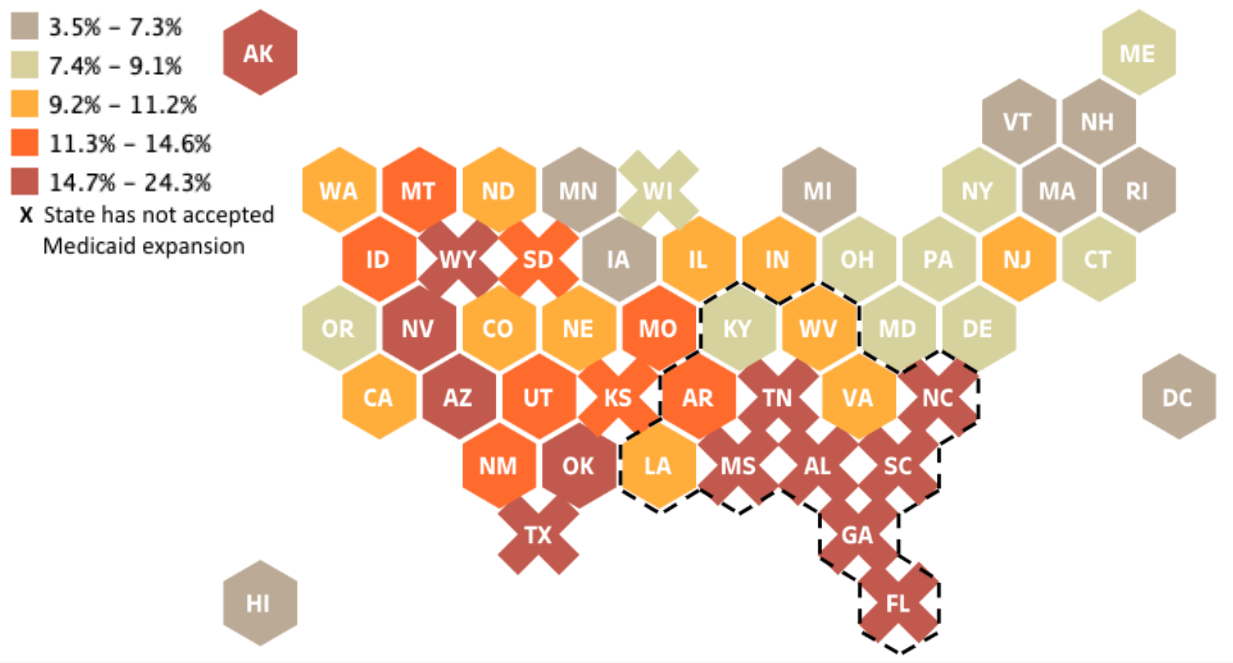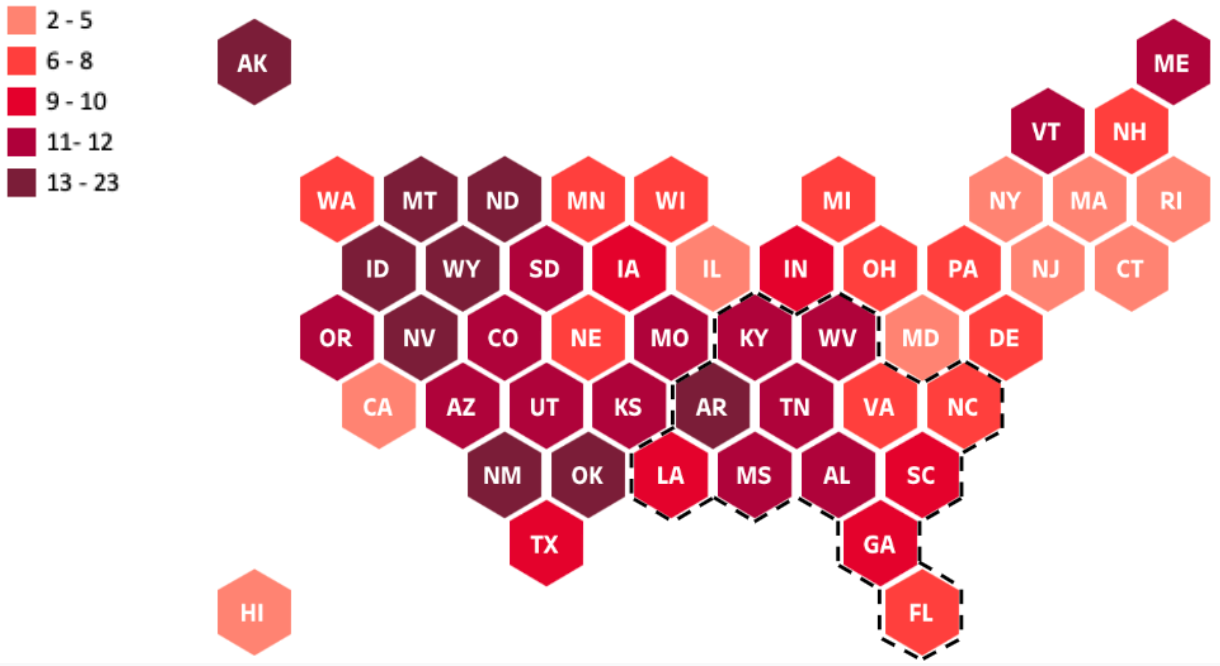Select a Data Category....
Explore Pandemic to Prosperity Data
Browse our data snapshots on topics like housing, jobs, health and more. View our full reports here.
Severe housing costs
In 2021, 31% of renters in Florida and 30% in Louisiana paid at least half of their total household income toward housing costs. West Virginia and Mississippi were close behind at 28%.
Medical Debt
As of February 2022, credit bureau data revealed that 17% of Southerners had medical debt, compared to 11% for non-Southerners. In some Southern counties, up to 44% of individuals had medical debt in collections.
Maternal Mortality
There were 1,031 pregnancy-related deaths in the South during 2019-2021, a rate of 36 deaths per 100,000 live births. During the same period, the maternal mortality rate was 22 deaths per 100,000 live births in the rest of the nation.
Employment Rates
Among people 16 years of age and older, the employment rate is down 0.9 points for the Black population, 1.3 points for the White population, and 1.5 points for the Hispanic population. It is up 0.8 points for the Asian population. The employment rate is down 1.1 points for men and 1.2 percentage points for women compared to the pre-pandemic February 2020 level.
Health Insurance Coverage
Despite substantial federal subsidies, seven states in the deep South (AL, FL, GA, MS, NC, SC, and TN) have not adopted Medicaid expansion. As a result, 15% of working-age Southerners lack health insurance compared to 11% in the rest of the United States.
Child Care Disruptions
As employment rates near pre-pandemic numbers, many families have struggled to keep up with fluctuating child care availability. Nearly 1 in 5 adults experienced a child care disruption at some point during the 4 weeks ending August 8, 2022.
Internet Access, by state
Southern states have less broadband internet access as a whole than the nation. Nearly 1 in 10 Southerners lacks broadband or a computer, including 1 in 7 Mississippians.
News Deserts
More than half of U.S. counties are what experts call “local news deserts” that have either no newspaper or only one (often a weekly or a thinly staffed daily). Southerners are more likely to live in news deserts, as 75% of Southern counties are news deserts, compared to 50% of non-Southern counties.
2020 Election Deniers
Despite there being no evidence of widespread fraud in the 2020 election and expert consensus that it was secure, more than 300 candidates across the country running for election this November have denied the results of the 2020 election, all Republicans. In the South, 58% of candidates for the U.S. House of Representatives have made these claims.
Voting Access
Southern states rank among the most difficult to vote, with South Carolina (43rd), Alabama (45th), Arkansas (48th), and Mississippi (49th) having some of the highest barriers to voting access.
Drinking Water Infrastructure
As early as 1988, the National Council on Public Works Improvements concluded that the nation’s infrastructure was barely adequate for needs of the day, and would not be sufficient for future population and job growth. More recent state-by-state report cards gave Mississippi a grade of “D.” Similarly, West Virginia’s report card (D) revealed that half of its treated water was lost through leaks in its struggling system. Louisiana received the lowest grade in the nation (D-).
Emergency Rental Assistance
The Covid recovery bills included a combined $45 billion in Emergency Rental Assistance (ERA) funds. Many Southern states have been slow to distribute these funds, including Alabama and Tennessee where only 41% of ERA funds have been spent, Arkansas where only 43% has been spent, and Georgia where only only 46% has been spent.
2020 Census Net Coverage Error, by age
For many decades, the U.S. Census has undercounted children. The 2020 undercount of young children 0-4 years old was larger than any Census since 1970. These undercounts reduce both political representation and funding for children nationwide.
Extreme Heat Days
Southerners are more likely to experience extreme heat days. In 2021, 92% of Southerners (versus 61% of non-Southerners) were exposed to 5+ days of extreme heat, and 64% of Southerners (versus 28% of non-Southerners) were exposed to 15+ days of extreme heat.
Worker Retention
Enabled by a strong job recovery, more than 4 million workers quit jobs in July 2022 in pursuit of new jobs with better wages and working conditions.
Job Growth
While almost 22 million jobs were lost when Covid hit, they have now, some two years later, been fully recouped. Helping workers build the skills necessary to fill these jobs, and to transition from old industries to new sustainable industries will require substantial retooling of current workforce development systems, ramping up paid apprenticeships, and a host of new approaches to rapidly onboard new workers.
Firearm suicide rates
Firearm suicides accounted for 26,322 deaths in 2021 compared to 20,966 firearm homicides and 1,544 other firearm deaths. The number of firearm suicides increased from 23,941 in 2019 to 24,292 in 2020, and then to 26,322 based on 2021 provisional data.
Long Covid
Among those who previously had Covid, 32% of Southerners (and 29% of non-Southerners) are currently experiencing prolonged symptoms, known as Long Covid. Nearly half (49%) of Covid survivors in West Virginia currently report Long Covid symptoms, which is the highest rate in the nation.
Mental Health Providers
The majority of psychologists have seen their waiting lists grow since the pandemic hit. And many Americans are turning to crisis hotlines, which are also seeing ballooning demand.
Health Insurance Coverage
Starting in 2010, the rates of the uninsured dramatically dropped with the implementation of the Affordable Care Act. And while uninsured rates improved across all racial/ethnic groups, disparities remained.




















